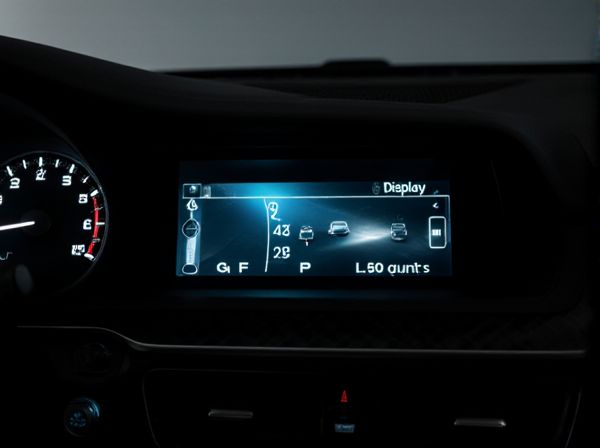
Photo illustration: Electroluminescent Display vs LED Display
Electroluminescent displays offer uniform brightness, wide viewing angles, and low power consumption, making them ideal for devices requiring thin, flexible screens. In contrast, LED displays provide higher brightness levels, vibrant colors, and better outdoor visibility, which are crucial for large screens and daylight use. Understanding these differences helps you choose the best display technology for your specific application needs.
Table of Comparison
| Feature | Electroluminescent Display (ELD) | LED Display |
|---|---|---|
| Brightness | Moderate brightness, ideal for low-light conditions | High brightness, suitable for all lighting environments |
| Power Consumption | Low power usage, energy-efficient for dashboards | Higher power consumption, depends on LED type and usage |
| Visibility | Uniform light distribution, reduces glare | Sharp and vibrant colors, better visibility in daylight |
| Durability | Good lifespan, sensitive to moisture and heat | Long lifespan, highly resistant to environmental factors |
| Cost | Typically higher initial cost | Generally lower cost and widely available |
| Refresh Rate | Stable, no flicker | Variable, potential flicker with cheaper models |
| Use Case | Best for subtle illumination and simple graphics | Ideal for dynamic visuals and high contrast displays |
Introduction to Display Technologies
Electroluminescent displays (ELDs) utilize a phosphor material that emits light when exposed to an electric field, offering uniform brightness and excellent visibility in low-light conditions. LED displays consist of light-emitting diodes that provide high brightness, energy efficiency, and long lifespan, making them ideal for outdoor and large-format applications. Both display technologies serve distinct purposes, with ELDs excelling in thin, flexible panels and LEDs dominating in vivid color and dynamic content presentation.
What is an Electroluminescent Display?
An Electroluminescent Display (ELD) uses a thin layer of phosphor that emits light when exposed to an electric field, offering uniform brightness and wide viewing angles. Unlike LED displays, which rely on individual light-emitting diodes, ELDs provide low power consumption and flexible, often thinner form factors. These displays are commonly used in applications requiring high visibility in low-light conditions, such as instrument panels and wearable devices.
What is an LED Display?
An LED display consists of light-emitting diodes arranged in a matrix to produce visual content with high brightness and energy efficiency. These displays offer superior contrast ratios, vibrant colors, and longer lifespan compared to traditional display technologies. Commonly used in outdoor advertising, digital signage, and large-format screens, LED displays excel in visibility under direct sunlight and dynamic content rendering.
Working Principles: Electroluminescent vs LED
Electroluminescent displays operate by applying an electric field to a phosphor material, causing it to emit light uniformly across the surface through electroluminescence, which results in thin, flexible, and evenly illuminated panels. In contrast, LED displays consist of light-emitting diodes where each diode acts as an individual light source, producing bright, energy-efficient illumination with high contrast and color accuracy. The fundamental difference in working principles lies in electroluminescent displays using a continuous phosphor layer activated by an electric field, while LED displays rely on discrete semiconductor light emitters.
Image Quality and Color Performance
Electroluminescent Displays (ELDs) offer superior uniformity and high contrast ratios, resulting in clearer images with deeper blacks compared to LED displays. LED displays provide brighter outputs with a wider color gamut, enhancing vividness and color saturation for dynamic visuals. While ELDs excel in consistent color accuracy and low power consumption, LED displays deliver more intense brightness levels suitable for outdoor and high ambient light conditions.
Power Consumption Comparison
Electroluminescent (EL) displays consume significantly less power than LED displays due to their passive emission nature, requiring only the voltage to excite the phosphor layer without constant current flow. LED displays need continuous current to illuminate each diode, leading to higher energy consumption, especially in large or high-brightness panels. This energy efficiency makes EL displays ideal for battery-powered devices and applications requiring minimal power usage.
Durability and Lifespan
Electroluminescent displays (ELD) offer superior durability due to their flexible thin-film design, which resists impact and vibration better than traditional LED displays. ELDs typically have a lifespan of around 10,000 to 20,000 hours, whereas LED displays can last between 50,000 and 100,000 hours under optimal conditions. Despite the longer lifespan of LEDs, their rigidity makes them more prone to physical damage compared to the more resilient ELD technology.
Applications and Use Cases
Electroluminescent displays excel in applications requiring thin, flexible screens with uniform backlighting, such as aviation instrument panels, automotive dashboards, and wearable devices, offering high visibility in low-light conditions. LED displays dominate in large-scale, high-brightness use cases like outdoor advertising, stadium screens, and traffic signs due to their energy efficiency, brightness, and long lifespan. While EL displays are favored for compact, low-power applications, LED displays are preferred for dynamic, colorful visuals in both indoor and outdoor environments.
Cost Considerations
Electroluminescent displays typically have a higher initial manufacturing cost due to the specialized materials and thin-film processes involved, whereas LED displays benefit from mass production and mature technology, making them generally more cost-effective. Maintenance expenses for electroluminescent displays are lower because they generate less heat and have fewer components prone to failure, while LED displays may require more frequent servicing in high-brightness and outdoor applications. Total cost of ownership analysis should include factors like energy consumption, expected lifespan, and application environment, with LEDs often favored in large-scale or high-brightness scenarios due to economies of scale.
Which Display Technology is Right for You?
Electroluminescent (EL) displays offer uniform brightness, thin design, and low power consumption, making them ideal for applications requiring flexible, low-light readability such as instrument panels and wearable devices. LED displays provide higher brightness, vibrant colors, and greater visibility in direct sunlight, suitable for outdoor signage, large screens, and multimedia use. Choosing between EL and LED depends on your need for energy efficiency, display size, brightness, and flexibility in device design.
 caratoz.com
caratoz.com